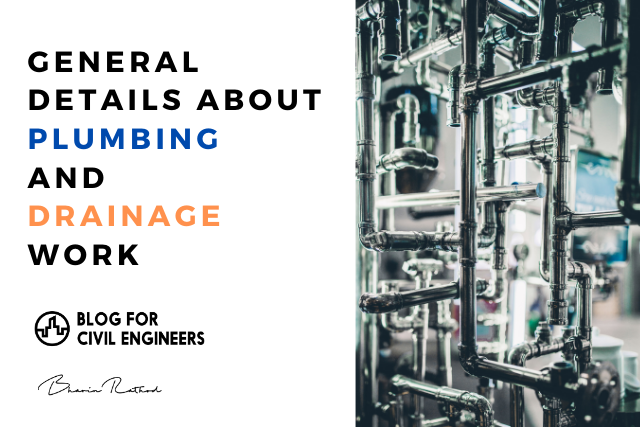GENERAL DETAILS ABOUT PLUMBING AND DRAINAGE WORK
Plumbing Definition:
Plumbing is installed in a building not only for convenience & comfort but also for sanitation & health. We would term the plumbing of a building to start from the water main, utilize the water in the entire building and right up to the connecting the sewage to the municipal sewer.
General Terms
a) Static Pressure:
Pressure head in term used in fluid mechanics to represent the internal energy of a fluid due to the pressure exerted on its container. It may also be called static pressure head or simply static head. The static head of pump is the maximum height (pressure) it can deliver. The capacity of the pump can be read from its Q-H curve (flow vs. height)
b) Head in Fluid Dynamics:
In fluid dynamics, head is the difference in elevation between two points in a column of fluid, and the resulting pressure of the fluid at the lower point.
c) Friction Loss:
Friction loss refers to that portion of pressure lost by resistance to flow exerted on fluids while moving through a pipe, hose or other limited space.
d) Water hammer:
Water hammer is a very loud banging, knocking or hammering noise in the pipes that occurs when the flow is suddenly turned off. It is caused by a pressure or shock wave that travels faster than the speed of sound through the pipes, brought on by a sudden stop in the velocity of the water or a change in the direction. It’s also been described as a rumbling, shaking vibration in the pipes.
Cavitation is defined as the phenomenon of vapor bubbles of a flowing liquid in a region where the pressure of the liquid falls below its vapor pressure.
f) Air Lock:
An air lock is gas trapped in a high point of a liquid – filled pipes system. The gas, being lighter than the liquid, rises to the highest point and restricts the flow of liquid. In very tall systems, the gas can prevent flow entirely. Flushing the system with high flow or pressure can help move the gas away from the highest point, or a tap/air vent valve can be installed to permit the gas to be vented.
g) Air Vent Valves:
A valve that releases air from a pipeline automatically without loss of water or introduces air into a line automatically if internal pressure becomes less than the atmospheric pressure is known as an Air Vent Valve.
h) Pressure Reducing Valve (PRV):
When water is supplied to the flats from the overhead tank the pressure of water increases as we go downwards due to weight of water column above it. Thus, the pressure is maximum at the ground floor / 1st floor and minimum at the top floor. Even in a Hydro-pneumatic system where water is supplied directly from pump to flats the pressure is higher on the lower floors of each zone. So, the pressures reducing Valves (PRV) is required in high rise building after every 24mtrs (80 feet) to regulate the pressure. PRV’s also helps in reducing the water consumption by about 30%
THANK YOU SO
MUCH , IF YOU LIKE THE CONTENT.
SUBSCRIBE FOR MORE SUCH INFORMATION ABOUT CIVIL ENGINEERING!!!!!














Comments